Abstract
An international collaborative study of broth dilution (MIC) and disk diffusion susceptibility testing of fluconazole was conducted by using a chemically defined medium (High-Resolution Antifungal Assay Medium; Oxoid Ltd., Basingstoke, United Kingdom) and standard test methods performed in eight reference laboratories. Ten yeast isolates were tested by each test method in duplicate on each of 3 separate days. The intralaboratory reproducibility of the MIC test was excellent; 95.7% of the replicate tests (n = 220) were within 2 doubling dilutions of the other values in the set for the eight laboratories. The intralaboratory reproducibility of the disk test was also good, with 91% of the replicate tests (n = 234) agreeing with each other within an arbitrarily chosen value of 4 mm. Interlaboratory agreement of MIC test results was acceptable, with 84% of the MICs agreeing within 2 doubling dilutions. In contrast, the interlaboratory agreement of the disk test was not good, with only 59% of test results agreeing within 4 mm. Comparison of the rank order of MICs obtained in each laboratory with the reference rank order gave an agreement of 70 to 80% (median, 80%) with the MIC test and 70 to 90% (median, 80%) with the disk test. These preliminary results are encouraging for the development of standardized testing methods for testing fluconazole.
Full text
PDF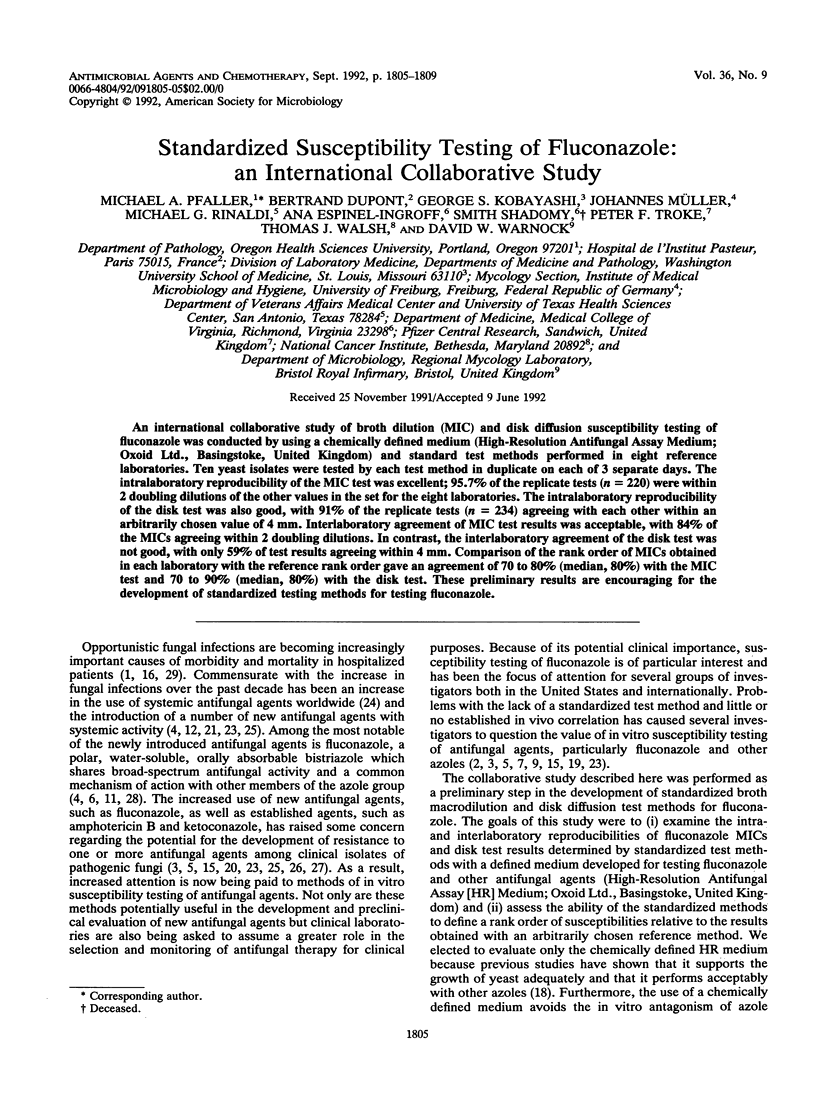
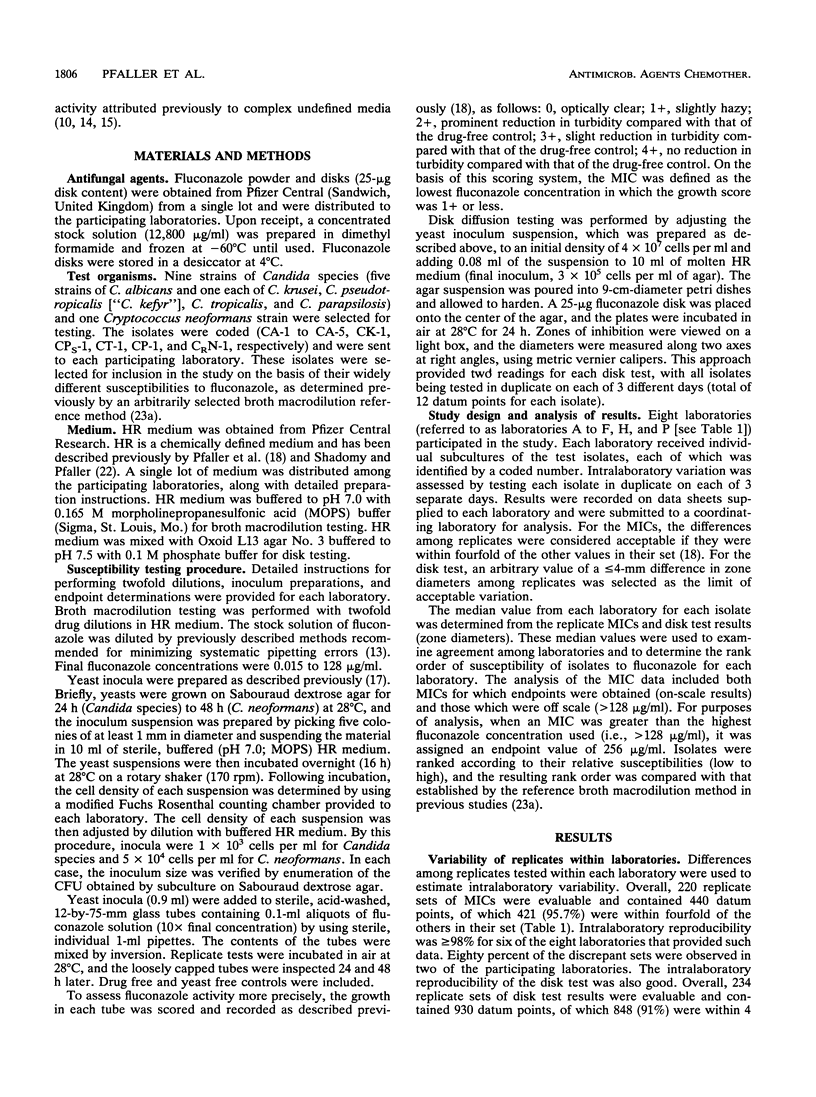
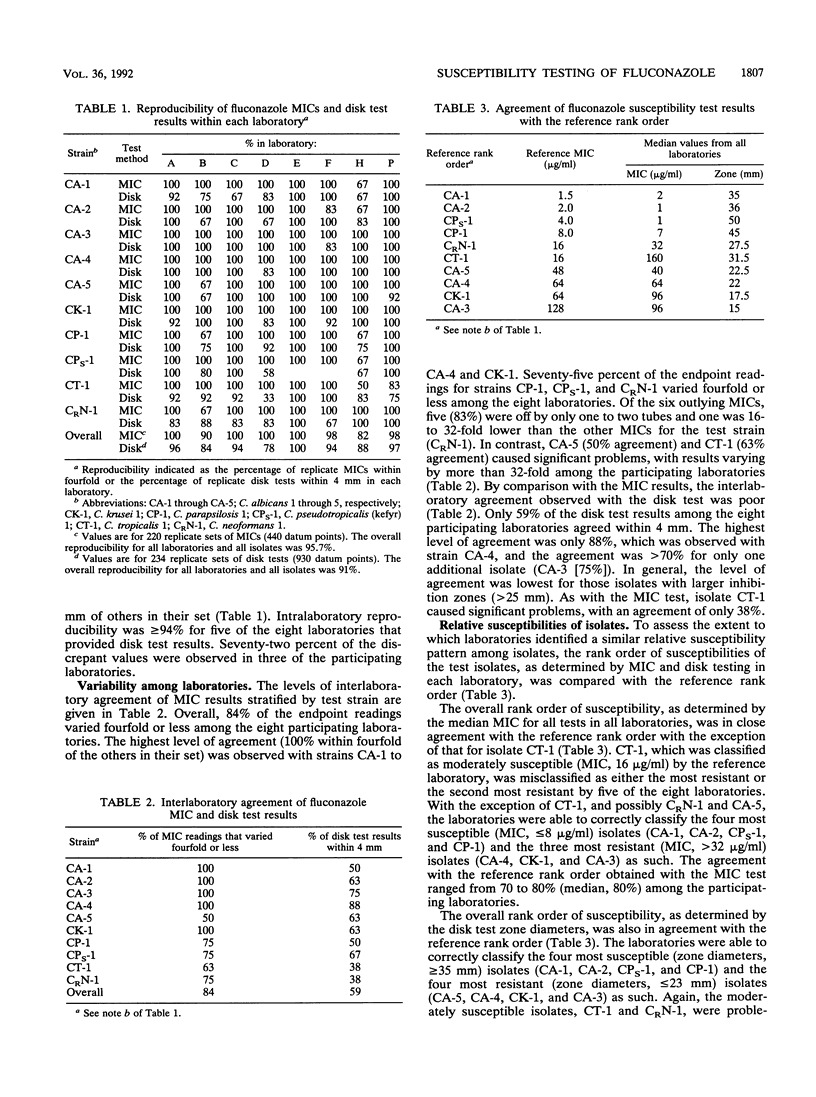
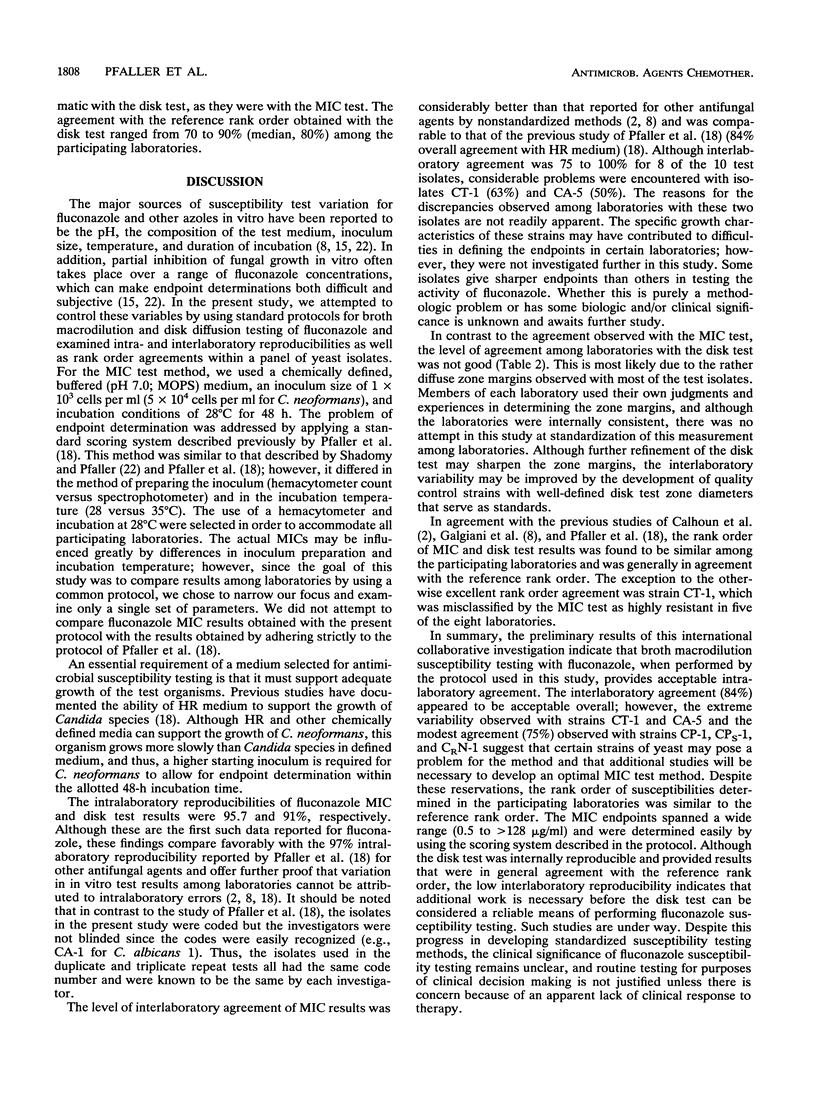
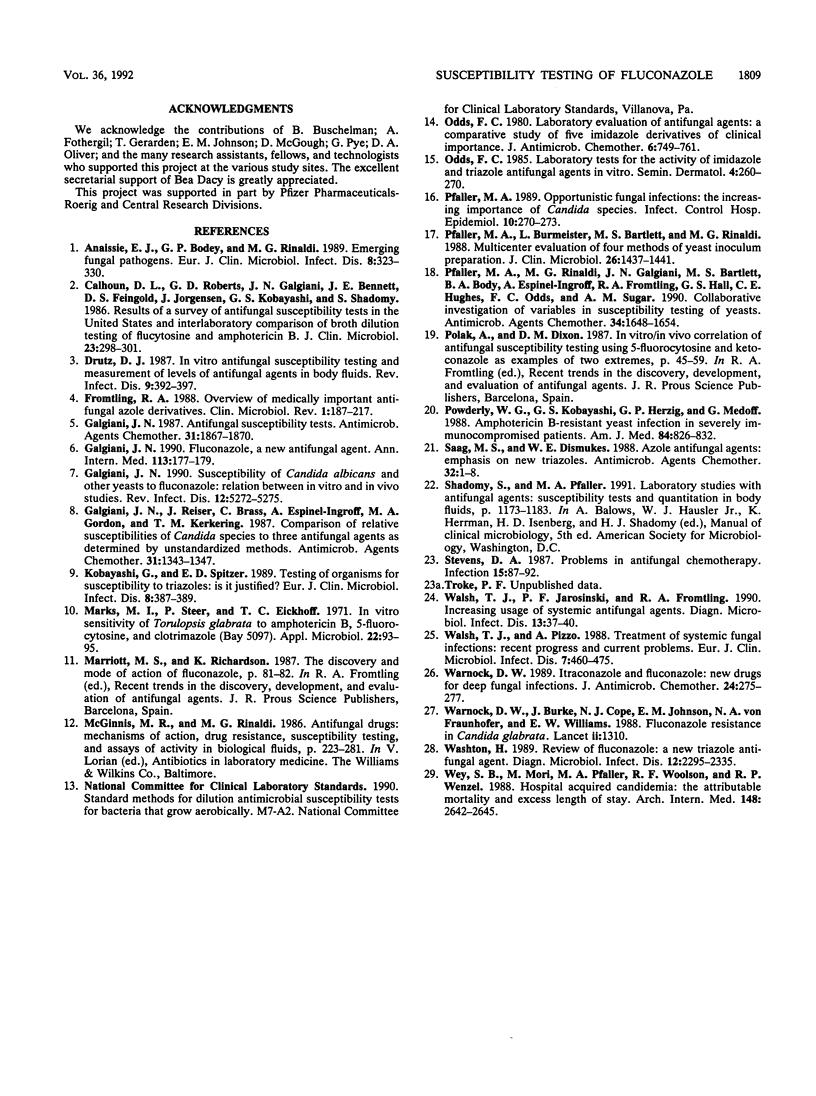
Selected References
These references are in PubMed. This may not be the complete list of references from this article.
- Anaissie E. J., Bodey G. P., Rinaldi M. G. Emerging fungal pathogens. Eur J Clin Microbiol Infect Dis. 1989 Apr;8(4):323–330. doi: 10.1007/BF01963467. [DOI] [PubMed] [Google Scholar]
- Calhoun D. L., Roberts G. D., Galgiani J. N., Bennett J. E., Feingold D. S., Jorgensen J., Kobayashi G. S., Shadomy S. Results of a survey of antifungal susceptibility tests in the United States and interlaboratory comparison of broth dilution testing of flucytosine and amphotericin B. J Clin Microbiol. 1986 Feb;23(2):298–301. doi: 10.1128/jcm.23.2.298-301.1986. [DOI] [PMC free article] [PubMed] [Google Scholar]
- Drutz D. J. In vitro antifungal susceptibility testing and measurement of levels of antifungal agents in body fluids. Rev Infect Dis. 1987 Mar-Apr;9(2):392–397. doi: 10.1093/clinids/9.2.392. [DOI] [PubMed] [Google Scholar]
- Fromtling R. A. Overview of medically important antifungal azole derivatives. Clin Microbiol Rev. 1988 Apr;1(2):187–217. doi: 10.1128/cmr.1.2.187. [DOI] [PMC free article] [PubMed] [Google Scholar]
- Galgiani J. N. Antifungal susceptibility tests. Antimicrob Agents Chemother. 1987 Dec;31(12):1867–1870. doi: 10.1128/aac.31.12.1867. [DOI] [PMC free article] [PubMed] [Google Scholar]
- Galgiani J. N. Fluconazole, a new antifungal agent. Ann Intern Med. 1990 Aug 1;113(3):177–179. doi: 10.7326/0003-4819-113-3-177. [DOI] [PubMed] [Google Scholar]
- Galgiani J. N., Reiser J., Brass C., Espinel-Ingroff A., Gordon M. A., Kerkering T. M. Comparison of relative susceptibilities of Candida species to three antifungal agents as determined by unstandardized methods. Antimicrob Agents Chemother. 1987 Sep;31(9):1343–1347. doi: 10.1128/aac.31.9.1343. [DOI] [PMC free article] [PubMed] [Google Scholar]
- Kobayashi G. S., Spitzer E. D. Testing of organisms for susceptibility to triazoles: is it justified? Eur J Clin Microbiol Infect Dis. 1989 May;8(5):387–389. doi: 10.1007/BF01964051. [DOI] [PubMed] [Google Scholar]
- Marks M. I., Steer P., Eickhoff T. C. In vitro sensitivity of Torulopsis glabrata to amphotericin B, 5-fluorocytosine, and clotrimazole (Bay 5097). Appl Microbiol. 1971 Jul;22(1):93–95. doi: 10.1128/am.22.1.93-95.1971. [DOI] [PMC free article] [PubMed] [Google Scholar]
- Odds F. C. Laboratory evaluation of antifungal agents: a comparative study of five imidazole derivatives of clinical importance. J Antimicrob Chemother. 1980 Nov;6(6):749–761. doi: 10.1093/jac/6.6.749. [DOI] [PubMed] [Google Scholar]
- Pfaller M. A., Burmeister L., Bartlett M. S., Rinaldi M. G. Multicenter evaluation of four methods of yeast inoculum preparation. J Clin Microbiol. 1988 Aug;26(8):1437–1441. doi: 10.1128/jcm.26.8.1437-1441.1988. [DOI] [PMC free article] [PubMed] [Google Scholar]
- Pfaller M. A. Infection control: opportunistic fungal infections--the increasing importance of Candida species. Infect Control Hosp Epidemiol. 1989 Jun;10(6):270–273. doi: 10.1086/646021. [DOI] [PubMed] [Google Scholar]
- Pfaller M. A., Rinaldi M. G., Galgiani J. N., Bartlett M. S., Body B. A., Espinel-Ingroff A., Fromtling R. A., Hall G. S., Hughes C. E., Odds F. C. Collaborative investigation of variables in susceptibility testing of yeasts. Antimicrob Agents Chemother. 1990 Sep;34(9):1648–1654. doi: 10.1128/aac.34.9.1648. [DOI] [PMC free article] [PubMed] [Google Scholar]
- Powderly W. G., Kobayashi G. S., Herzig G. P., Medoff G. Amphotericin B-resistant yeast infection in severely immunocompromised patients. Am J Med. 1988 May;84(5):826–832. doi: 10.1016/0002-9343(88)90059-9. [DOI] [PubMed] [Google Scholar]
- Saag M. S., Dismukes W. E. Azole antifungal agents: emphasis on new triazoles. Antimicrob Agents Chemother. 1988 Jan;32(1):1–8. doi: 10.1128/aac.32.1.1. [DOI] [PMC free article] [PubMed] [Google Scholar]
- Stevens D. A. Problems in antifungal chemotherapy. Infection. 1987 Mar-Apr;15(2):87–92. doi: 10.1007/BF01650203. [DOI] [PubMed] [Google Scholar]
- Walsh T. J., Jarosinski P. F., Fromtling R. A. Increasing usage of systemic antifungal agents. Diagn Microbiol Infect Dis. 1990 Jan-Feb;13(1):37–40. doi: 10.1016/0732-8893(90)90051-v. [DOI] [PubMed] [Google Scholar]
- Walsh T. J., Pizzo A. Treatment of systemic fungal infections: recent progress and current problems. Eur J Clin Microbiol Infect Dis. 1988 Aug;7(4):460–475. doi: 10.1007/BF01962595. [DOI] [PubMed] [Google Scholar]
- Warnock D. W., Burke J., Cope N. J., Johnson E. M., von Fraunhofer N. A., Williams E. W. Fluconazole resistance in Candida glabrata. Lancet. 1988 Dec 3;2(8623):1310–1310. doi: 10.1016/s0140-6736(88)92919-4. [DOI] [PubMed] [Google Scholar]
- Warnock D. W. Itraconazole and fluconazole: new drugs for deep fungal infection. J Antimicrob Chemother. 1989 Sep;24(3):275–277. doi: 10.1093/jac/24.3.275. [DOI] [PubMed] [Google Scholar]
- Wey S. B., Mori M., Pfaller M. A., Woolson R. F., Wenzel R. P. Hospital-acquired candidemia. The attributable mortality and excess length of stay. Arch Intern Med. 1988 Dec;148(12):2642–2645. doi: 10.1001/archinte.148.12.2642. [DOI] [PubMed] [Google Scholar]


